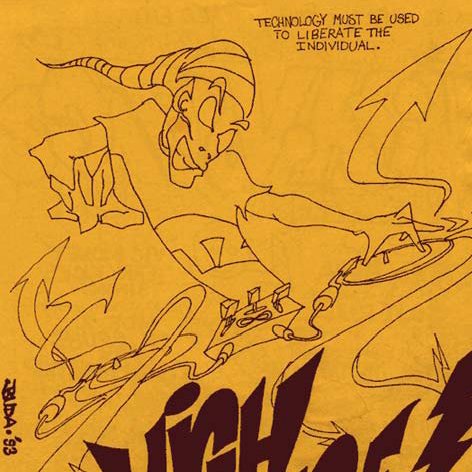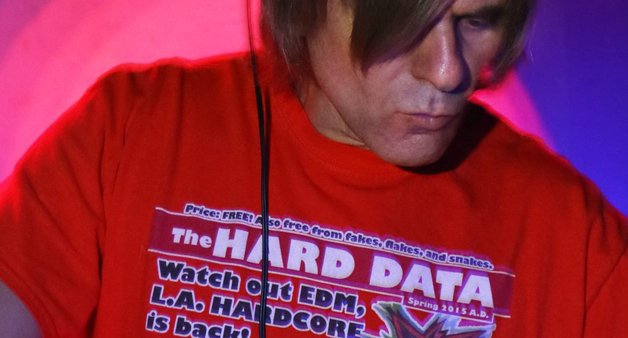Hamburg is a more than 800 year old harbor town in the north of Germany. As such, it was always also a hotspot for a wide range of subcultures, cranks and crooks, rowdy sailors, prostitutes, pirates that found their place in shady pubs, back alleys and similar dark places.
I entered Hamburg in 1980 by birth, so I can’t tell you much about the 60s or 70s of Hamburg, but in the 80s, it was a place for anarchists, punks, rioters and similar people – creating the current for places of alternate music and political views to be set up. This is a bit of a back story for what happened in the 90s in Hamburg, regarding the then emerging hardcore techno scene.
Fischkopf
Container Records was a record store in the red light zone of Hamburg – the Reeperbahn – one story above a store for alternate clothing. It was focused on techno music only and one of the largest (or the largest?) of such stores in Hamburg. They also were involved in other things, such as running a record label also named Container. And this Container Records had a sublabel called Fischkopf.
The first generation of Fischkopf was a group of people around Martin, the owner of Container Records; I don’t know exactly who was directly involved in running the label, but Cybermouse, DJ Raid and Christoph De Babalon are names I heard over the years (please correct me).

Cybermouse got to Fischkopf because it was noted that he bought only the most extreme and obscure records at the store; something that made the crew think he’d fit right in, apparently. So the first Fischkopf record was released, “Surprise Attack” by Cybermouse. They were all done on an Amiga computer using tracker software and a special FX software; actually, the tracks were first released on a diskette magazine called “Neurowaver” (if you don’t know what a diskette magazine is, ask Google).
Cybermouse’s debut was followed by Christoph De Babalon’s debut, the “Love Under Will” EP, named after Aleister Crowley obviously. On it we find some of the most haunting music with “jungle beats” made in this era.
After a few more EPs, the management changed, and Hardy Storz took over. He steered Fischkopf into the direction that brought worldwide acclaim to it. Releasing experimental, intellectual music that at the same time is hardcore techno. In one of the rare interviews with him, he states that he was annoyed by the turn gabber had taken at that time; becoming more dumb, simplistic, macho. And Fischkopf for sure was the opposite of that.
Fischkopf had most of the major players in the more refined hardcore scene in those days on it’s rooster: Patric C as Eradicator, Lasse Steen with a variety of aliases, Nawoto Suzuki as Burning Lazy Persons, Taciturne, Amiga Shock Force and EPC, and the Michelson sisters Auto-Psy and No Name. Especially these two female fighters brought some of the most interesting music to this label; tracks that are so complex and structured and finetuned, that the word “hardcore” is almost too brutish for them.
Although the pressing for “Fisch” releases were limited to 500, they quickly got known worldwide in the more underground scenes. After a while also parties were set up by the Fisch crew, again in the red light district of Hamburg. These parties attracted a wide range of performers such as Rage Reset, DJ Entox, La Peste, and many many more. Without going too much into this, let’s just repeat Taciturne’s summary that the amount of fog issued in these nights in these dark, strobe filled rooms would’ve clouded a soccer arena.
Even though opposing the “commercial” “Dutch” “gabber” scene, Fischkopf spawned one big hit in exactly that scene; Taciturne’s totem which is still sought after, after all these years.
Fischkopf faltered in 1997; the exact reasons are not known, but talk is about disagreement on the direction to take Fischkopf between Hardy and Container; or that Fisch just did not generate enough “dough”.
One more release appeared in 1998 (and a test pressing of a “Fisch 26” by Cybermouse), only for Fischkopf to disappear completely after that.
Interesting fact: at one point, Alec Empire and Somatic Responses were planned for a Fischkopf release too.
Listening suggestion: Taciturne – 6 Fragmente In Der Chronologie Des Wahnsinns
Cross Fade Entertainment
DJ Raid, who was also involved in Fischkopf, set up this label with Paul Snowden and Christoph De Babalon. The word “hardcore” only vaguely fits here; this is just brilliant, brilliant subcultural music.
The first release was the premier release of Somatic Responses, who took the world by storm in the years (or rather, even decades) that followed. This was still a lot different to their later style: heavy, heavy distorted drums (or noises) in a 4/4 style, with experimental sounds in a vain of early synth experimental music. As fierce as fierce gets.

The second release was done by Christoph De Babalon and Paul Snowden, aptly named “We Declare War”. Paul Snowden’s site has some of the most distorted acid, and CDB brings us assault troop breakbeat tracks here, going on from his Fischkopf release.
In a rare German TV interview, CDB stated CFET to him is “auteur music”, in the sense that the artist take their music in their own individualist direction, regardless of trends. And the releases give proof of that.
Later, we find some fine breakcore releases on CFET.
I can’t find much info on this, but according to defunct websites, the CFET personnel was once involved in the “Repulsion Parties”, taking place inside the “Rote Flora”, the most infamous squat in Hamburg. Line ups included artists like E-De Cologne, Alec Empire and Somatic Responses.
CFET left Hamburg with Jan (CDB) and Paul moving to Berlin.
Listening suggestion: Christoph De Babalon & Paul Snowden – We Declare War
Nordcore
No Hamburg hardcore history text is complete without Nordcore. Nordcore started as “Die Tekknokraten” organizing small techno and hardcore parties, changing the name later. As Nordcore they run a weekly hardcore club called “The Box”, in the midst of Hamburg. I think this was one of the only regular hardcore clubs worldwide that existed in the 90s outside of Netherlands and Belgium; the Bunker in Berlin being another important location.
Almost all the big names in hardcore, gabber and speedcore scene played in the box; Speedfreak, the PCP crew including Smash? (sic), BSE DJ team, Laurent Hô, E-De Cologne… And also a lot of the Dutch DJs.
It were speedy times, but The Box had to close in 1996; much too soon!
The parties got bigger though, and Nordcore moved to the Markthalle, usually a location for rock and pop bands, with their “Operation Nordcore” parties, again attracting all the “big name” performers to play.

Nordcore continued their hardcore journey way long into the 2000s in Hamburg; and maybe we will see them resurface?
They also ran a record label, called Nordcore Records; and, beginning with issue 5, compiled the “Terrordrome” CDs, the biggest name in hardcore CDs in the 90s, only eclipsed by Thunderdome.
Listening suggestion: Nordcore GMBH – Hartcore Will Never Die
Blut
After Hardy left Container, he set up his own record store, called Otaku Records, again with a “Hardcore” label, called Blut Records; and in many way a spiritual successor to Fischkopf Records.
The rooster was similar too: Taciturne, Nawoto, Amiga Shock Force and EPC. We also find a record that was originally planned as Fischkopf 25 here, Taciturne with Ebizieme.

The sound was taken a step farther in extremism with this label, so be prepared for a noise assault on your ears; but, again, a sensible one.
The record store itself was also a good destination to shop for obscure and not so obscure hardcore, speedcore and breakcore records in Hamburg, with it’s own special charme.
Blut never officially ended, but there was no release after Blut 6; a shame!
Listening Suggestion: Taciturne & EPC – Vendetta Vol.1 EP
Hardcore didn’t end in the 90s in Hamburg, but that, my child, is written in another tome…














